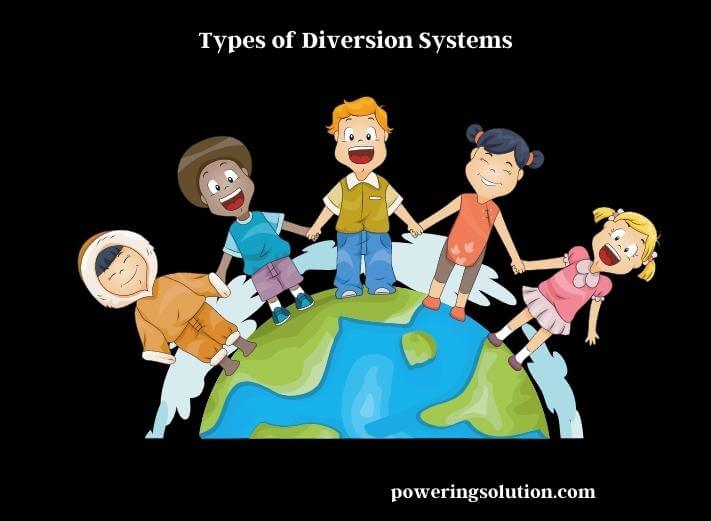Safety is a critical concern for organizations across all industries. Hazards can be present in the workplace in the form of hazardous materials, and if not handled and stored properly, they can pose a significant risk to the workforce and the environment. Diversion systems are safety measures designed to mitigate these risks by redirecting hazardous materials away from the workforce, reducing the likelihood of accidents, and minimizing environmental damage.

We will explore the importance of diversion systems in promoting safety in the workplace. We will discuss the different types of diversion systems available today, the factors that organizations should consider when choosing a system, and the benefits of working with a reputable provider.
What Are Diversion Systems?
Diversion systems are safety measures used to redirect hazardous materials away from the workforce and the environment, reducing the risk of accidents. These systems work by diverting hazardous materials through a network of pipes and valves to a safe location, where they can be safely stored or disposed of.
Diversion systems can be installed in various industries, including chemical plants, oil and gas refineries, and pharmaceutical manufacturing facilities, among others.
Types of Diversion Systems
There are several types of diversion systems available today, each designed to address specific hazards and mitigate risks associated with hazardous materials. Let’s take a look at some of the most common types of diversion systems:

Inerting Systems
Inerting systems work by displacing the oxygen in a confined space with an inert gas, such as nitrogen or argon. This reduces the risk of fire and explosion by preventing the ignition of flammable materials.
Deluge Systems
Deluge systems use a network of sprinkler heads connected to a water supply to quickly and effectively extinguish fires. These systems are commonly used in areas where flammable liquids are stored or processed.
Suppression Systems
Suppression systems are designed to detect and suppress fires using various methods, such as foam, dry chemicals, or carbon dioxide. These systems are ideal for areas where traditional sprinkler systems may not be effective, such as areas with high ceilings or where water damage could be a concern.
Explosion Suppression Systems
Explosion suppression systems work by detecting and suppressing explosive events before they can cause significant damage. These systems are commonly used in areas where combustible dust or gases are present, such as grain silos or chemical plants.
Note
Each type of diversion system has its own unique benefits and drawbacks, and organizations should consider the specific hazards present in their workplace when choosing a system. It is also important to ensure that the chosen system meets any relevant regulations governing the handling and storage of hazardous materials. Working with a reputable provider can help ensure that the right system is selected and installed properly.
Details About Benefits of Diversion Systems
Increased Safety
Diversion systems are designed to reduce the risk of accidents and protect the workforce from hazardous materials. They are an essential component of any safety plan and can help prevent injuries, fatalities, and environmental damage.
Regulatory Compliance
Many industries are subject to strict regulations regarding the handling and storage of hazardous materials. Diversion systems can help organizations comply with these regulations and avoid costly fines and penalties.
Reduced Insurance Costs
Organizations that implement diversion systems may be eligible for reduced insurance costs, as they are seen as a lower risk by insurance providers.
Enhanced Reputation
Organizations that prioritize safety are viewed more favorably by customers, employees, and stakeholders. The implementation of diversion systems can enhance an organization’s reputation and brand image.
It’s important to know about ground-source heat pumps. Follow this for full information.
Choosing the Right Diversion System
Choosing the right diversion system is crucial to ensure maximum safety in the workplace.
Hazards Present
The first step in choosing a diversion system is to identify the hazards present in the workplace. This can be done through a hazard assessment, which involves evaluating the potential risks associated with hazardous materials and identifying the most likely scenarios for accidents. Once the hazards have been identified, the appropriate diversion system can be selected based on its ability to mitigate those specific risks.
Industry Standards and Regulations
Organizations must comply with industry standards and regulations governing the handling and storage of hazardous materials. These standards and regulations vary depending on the industry and the type of material being handled. It is important to select a diversion system that meets all relevant regulations to avoid fines, legal action, or even accidents caused by non-compliance.
Cost
The cost of a diversion system is an important factor to consider, but it should not be the only factor. While it may be tempting to choose the cheapest option available, it is important to consider the long-term cost of the system, including maintenance, repair, and replacement costs. It is also important to consider the potential cost of accidents that could be prevented with a more effective diversion system.
The expertise of the Provider
Working with a reputable provider is essential to ensure that the chosen diversion system is installed and maintained properly. The provider should have experience working with the specific hazards present in the workplace and should be able to provide references from other satisfied customers. It is also important to ensure that the provider offers ongoing maintenance and support to ensure that the system remains effective over time.
Factors to Consider That Organizations Should Take Into Account
When it comes to choosing a diversion system, there are several factors to consider. The size and layout of the facility can impact the effectiveness of a diversion system. For example, in a large facility with multiple buildings, a centralized system may be more effective than individual systems for each building. It is important to consider the location and layout of hazardous materials and potential ignition sources when selecting the appropriate system.
All diversion systems require maintenance to remain effective over time. It is important to select a system that is easy to maintain and that has a low maintenance requirement to minimize downtime and ensure consistent performance.
The response time of a diversion system can be critical in preventing accidents and minimizing damage. It is important to select a system that can respond quickly to potential hazards to prevent accidents from occurring.
Effective use of a diversion system requires proper training and education of personnel. It is important to select a system that is easy to use and that comes with comprehensive training and education resources to ensure that personnel can use the system effectively.
Some diversion systems may not be compatible with other safety systems, such as fire suppression systems or ventilation systems. It is important to consider the compatibility of the chosen system with existing safety systems to ensure that all systems work together effectively.
Working with a Provider for Selecting and Implementing a Diversion System
Working with a reputable provider is essential when selecting and implementing a diversion system.
Experience and Expertise
The provider should have experience working with the specific hazards present in the workplace and should be knowledgeable about the latest diversion system technologies and industry standards. They should be able to provide references and case studies to demonstrate their expertise and should have a proven track record of success in implementing diversion systems.
Customization and Flexibility
Different facilities have different needs, and the provider should be able to customize the diversion system to meet the specific requirements of the facility. They should also be flexible in their approach and willing to work with the organization to find the most effective solution for their needs.
Installation and Maintenance Support
The provider should offer installation and maintenance support to ensure that the system is installed correctly and is properly maintained over time. They should provide ongoing training and support to ensure that personnel is able to use the system effectively and that the system remains effective over time.
Responsiveness and Communication
The provider should be responsive to the needs of the organization and should communicate effectively throughout the implementation process. They should be available to answer questions and provide support as needed and should be proactive in identifying and addressing potential issues with the system.
Cost and Value
The provider should offer a fair and transparent pricing model that accurately reflects the value of the system and the level of support provided. It is important to consider the long-term value of the system, including its effectiveness in preventing accidents and minimizing damage, when evaluating the cost of the system.
Verdict
Diversion systems play a critical role in maximizing safety in facilities where hazardous materials are present. If you divert potential hazards away from ignition sources, diversion systems can prevent accidents and minimize damage, protecting both workers and the environment.
When selecting a diversion system, organizations should consider factors such as the type of hazard present, the size and layout of the facility, maintenance requirements, response time, and compatibility with other safety systems. Working with a reputable provider can also help organizations select and implement an effective diversion system that meets their specific needs.
Investing in a state-of-the-art diversion system is not only crucial for safety, but also for compliance with industry regulations and standards. It can also provide long-term value by preventing costly accidents and minimizing downtime.
